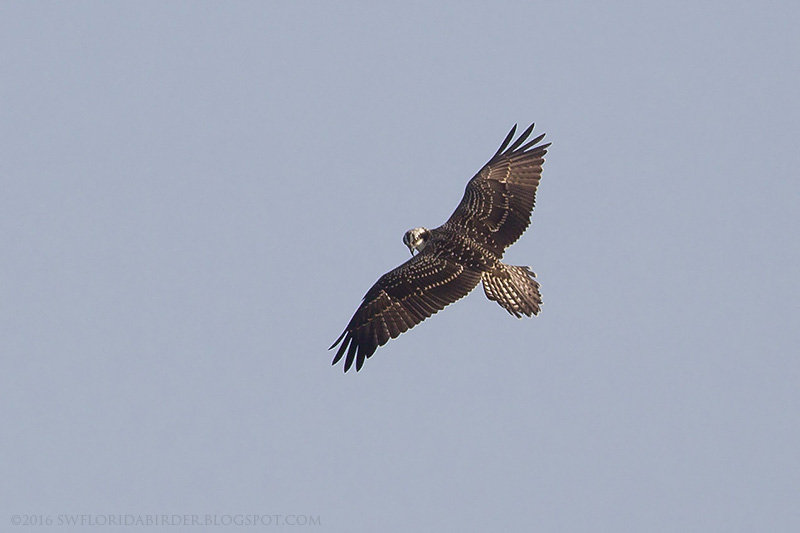An early May visit to Little Estero Lagoon south of Fort Myers Beach was very rewarding with a walk of the beach beginning at the Wyndham Garden Hotel.
The Black Skimmer above (image 1) was photographed at Little Estero Lagoon in May 2016.
The north lagoon was active with wading birds like I had never seen before at this location. There was a feeding frenzy underway the likes of which I have only seen at Ding Darling National Wildlife Refuge. The low light from the barely risen sun and shadow from the adjacent highrise building made photography prohibitive.
The Brown Pelican above (image 2) was photographed at Little Estero Lagoon in May 2016.
The Great Blue Heron above (image 3) was photographed at Little Estero Lagoon in May 2016.
The Black Skimmer above (image 4) was photographed at Little Estero Lagoon in May 2016.
The Black Skimmer above (image 5) was photographed at Little Estero Lagoon in May 2016.
The Common Grackle above (image 6) was photographed at Little Estero Lagoon in May 2016.
The Peregrine Falcon above (image 7) was photographed at Little Estero Lagoon in May 2016.
The Reddish Egret with nesting material above (image 8) was photographed at Little Estero Lagoon in May 2016.
The Wilson's Plover above (image 9) was photographed at Little Estero Lagoon in May 2016.
The Mottled Duck above (image 10) was photographed at Little Estero Lagoon in May 2016.
The Sanderling with prey above (image 11) was photographed at Little Estero Lagoon in May 2016.
The Sanderling with prey above (image 12) was photographed at Little Estero Lagoon in May 2016.
The Sanderling with prey above (image 13) was photographed at Little Estero Lagoon in May 2016.
The Ruddy Turnstone above (image 14) was photographed at Little Estero Lagoon in May 2016.
The Sanderling above (image 15) was photographed at Little Estero Lagoon in May 2016.
The Sanderling above (image 16) was photographed at Little Estero Lagoon in May 2016.
The Ruddy Turnstone with prey above (image 17) was photographed at Little Estero Lagoon in May 2016.
The Ruddy Turnstone with prey above (image 18) was photographed at Little Estero Lagoon in May 2016.
The Black-bellied Plover with prey above (image 19) was photographed at Little Estero Lagoon in May 2016.
The Black-bellied Plover above (image 19) was photographed at Little Estero Lagoon in May 2016.
The Wilson's Plover above (image 20) was photographed at Little Estero Lagoon in May 2016.
The Sanderling above (image 21) was photographed at Little Estero Lagoon in May 2016.
The Least Tern above (image 22) was photographed at Little Estero Lagoon in May 2016.
The Black Scoter above (image 23) was photographed at Little Estero Lagoon in May 2016.
The Snowy Plover above (image 24) was photographed at Little Estero Lagoon in May 2016.
The Snowy Plover above (image 25) was photographed at Little Estero Lagoon in May 2016.
The Osprey above (image 26) was photographed at Little Estero Lagoon in May 2016.
The Wilson's Plover above (image 27) was photographed at Little Estero Lagoon in May 2016.
By the time I made my way a short distance south, the light had improved. There was evidence of courtship and nesting behavior which stretched nearly the entire way to Carlos Point.
The Black Scoter above (image 28) was photographed at Little Estero Lagoon in May 2016.
Please be sure to be reminded about this weekly Southwest Florida Wildlife Blog with the email gadget located at the top of the page.
The Black Scoter above (image 29) was photographed at Little Estero Lagoon in May 2016.
Please also see Little Estero Lagoon Spring Nesting: Part II































Hello! I was wondering about the differences between the Sanderling image 15 and Sanderling image 16. Is one a juvenile and one an adult? Thank you!
ReplyDeleteIt must take a lot of experience to tell the difference between all the shorebirds!
Image 15, Jacquelin, is representative of the plumage for Sanderling that is seen at the beaches in SW Florida most of the year. It took a very long time for me to be able to differentiate this species from other similar shorebirds. I thank Robert Doiron for his assistance in helping me identify this species correctly. The size of this shorebird is most important to pay attention to in the field. Especially look at the bill and feet as well. To differentiate shorebirds I look at size first, then other distinguishing features including the color of legs and bill shape. Image #16 shows an adult while #15 shows a juvenile.
DeleteI tried to leave a comment a few moments ago, but it seems to have disappeared. Sorry if this is duplicated.
DeleteI wanted to say thank you for this information. It's very helpful.
I also appreciated your advice in a previous post to learn to identify bird songs and calls. The Cornell Lab has an interactive website that allows users to match the birdsong with the bird. I have a long way to go to be able to identify them on my own. Here is the link for those who'd like it:
https://academy.allaboutbirds.org/bird-song-hero/
It appears that your Bird Song game will be expanded further over time.
DeleteLoved the low angle on the shorebirds Bob! The Scoter was a great find as well. The sanderlings in basic and alternate plumage were also a treat!
ReplyDeleteThank you, Hemant.
Delete